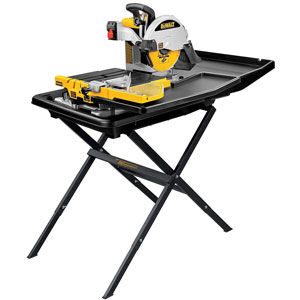8 Best Wet Tile Saws (for Ceramic, Porcelain, and Glass)

Whether you’re a professional mason or just need a reliable wet saw for frequent DIY tile projects, picking out the ideal model can be a nightmare due to all of the competition out there.
As this is an investment that can literally make or break your tile project, we’ve done most of the homework for you. The following eight selections are all top runners for the best tile saw, depending upon your specific needs.
Our 8 Favorite Wet Tile Saws
| Product | Blade Size | Max Rip | Max Diag | Weight | |
|---|---|---|---|---|---|
 | DeWalt D24000S | 10" | 24" | 18" | 69 lbs |
 | Ridgid R4040S | 8" | 24" | 18" | 49 lbs |
 | Chicago Electric 69275 | 10" | 24" | 18" | 70 lbs |
 | Ridgid R4021 | 7" | 24" | 12" | 27 lbs |
 | Skil 3550 | 7" | 18" | 12" | 24 lbs |
 | Porter-Cable PCE980 | 7" | 17" | 12" | 27 lbs |
 | Skil 3540 | 7" | 8" | 8" | 18 lbs |
 | QEP 22650Q | 7" | n/a | n/a | 23 lbs |
Tile Saw Reviews
#1 – DeWalt D24000S 10-Inch Wet Tile Saw w/ Stand

The ten-inch blade can rip cut 25 or 28 inch tiles or plunge and cut an 18-inch square tile along the diagonal. Dual adjustable water nozzles and removable front and side water attachments help prevent backsplash while keeping the blade cool. The cut line indicator and stainless steel rollers ensure accurate cuts with as small an error margin as 1/32 inches on an 18-inch cut.
Owners love how sturdy the stand is, as well as the pump’s strength. While weighing in at 69 pounds doesn’t exactly make it a feather, it’s built tough for heavy usage while still being easy to transport.
The manual for this saw can be a bit confusing, so it might be better to check out a guide on YouTube when first assembling and using. Also, note that the saw can burn through blades pretty quick due to its power. You may also wish to invest in longer water lines for a more comfortable setup.
>> Check current price <<
#2 – Ridgid R4040S 8-Inch West Tile Saw w/ Stand

A removable five gallon water tray and wrap around rubber splash guard help keep the work surface clean. With this saw, you can rip 24-inch tiles or cut 18-inch tiles on the diagonal and up to 2 ¾ inches deep.
Owners of the R4040S love its sturdy design and laser guide. It makes setting up, breaking down, and cleaning a breeze. A lifetime parts and service warranty upon registration just add icing to an already attractive cake.
As nice as the overall design is, the water tray doesn’t lock in place, adding a risk of spills when at a busy worksite. It’s also a rather noisy model and any jams can make the tile tray slide less efficiently, affecting the quality of your cuts.
>> Check current price <<
#3 – Chicago Electric 69275 10-Inch Industrial Tile/Brick Saw

The adjustable cutting head allows for a 24-inch cutting capacity on tiles and bricks up to 3.5 inches thick, as well as straight, 22.5 degree, and 45 degree angle cuts.The saw is built from heavy duty cast alloy and steel frame for strength and reduced vibration.
The 69275 (and its sibling, the 62391) are tile/brick saws, meaning they not only work on ceramic tile, but also do an excellent job with red brick. The unit works best when putting the water pump in a separate (covered) bucket and using a six foot length of 5/16 inch tubing from Home Depot or your local hardware store.
Most of the complaints regarding the 69275 are regarding missing or damaged parts upon delivery. Be sure to check the contents upon arrival. Also, note that the unit doesn’t come with the stand it’s sometimes pictured with. It’s well worth the additional investment, however.
>> Check current price <<
#4 – Ridgid R4021 7-Inch Table Top Wet Tile Saw

For a smaller wet saw, the R4021 is very well-built. The handle makes it quite portable, while also making it easy to set up and use. Best of all, it’s backed by Ridgid’s lifetime parts and service warranty.
Some users have complained that the blade life isn’t as long as they’d expected. This might be related to the tile material, which hasn’t been reported in these incidents. It should be noted that white tiles often pick up surface marks when using this saw, so keep that in mind.
>> Check current price <<
#5 – Skil 3550-02 7-Inch Wet Tile Saw

The rust resistant aluminum top extends to accommodate tiles up to 18 inches square. To aid in cleanup and splash reduction, the saw includes an innovative Hydro Lock water containment system.
When you want an efficient wet saw without paying a lot, the 3550 is an excellent choice. It cuts ceramic tile easily and is easy to clean and maintain. You can use the included blade or swap for one that suits your project.
Note that the 3550 is not designed for professional-grade jobs. As such, it’s important to keep the cutting surface clean to avoid damaging the tiles or causing the motor to jam.
>> Check current price <<
#6 – Porter-Cable PCE980 7-Inch Wet Tile Saw

While not the fastest at 2850 RPMs, this small wet tile saw’s roll cage makes this far more durable than the competition while still allowing it to be stored easily.
Owners love how much easier drainage is with the plug and basin. It makes for a great addition for home workshops as well, due to its fairly quiet running and high storability.
There has been some confusion about the PCE980, according to the most recent tile saw reviews. Among these are at least one claim that Porter-Cable has discontinued this item and that replacement parts are hard to come by.
Whether or not the saw is out of production has yet to be verified, but it’s something that should be considered when planning to purchase this tool.
>> Check current price <<
#7 – Skil 3540-02 7-Inch Wet Tile Saw

While by no means a professional-grade model, this little saw is able to handle everything from simple ceramic to glass mosaic tile and even Arkansas stone.
This model is incredibly effective on smaller subway tile and tends to have a long blade life. It’s easy to assemble and stores easily due to its small size. At only 18 pounds, it’s also quite portable for when you need to do a job on the go.
As with all too many other tools, many consumers have received refurbished models after paying for a new one. This has led to a number of breakages or accuracy issues. Be sure to check upon arrival to ensure the tool is new and undamaged.
Finally, be warned that this is much noisier than some of its Skil siblings, so you may have to skip those late-night crafting sessions.
>> Check current price <<
#8 – QEP 22650Q 650XT 7-Inch Wet Tile Saw

An eight-inch extension allows you to increase either side of the table to accommodate larger tiles. Meanwhile, the unit has a sturdy steel table and frame to ensure it can take some punishment.
This is one of the best cheap wet saws for dealing with subway tile. The small size and light weight make it a great tool for contractors who need to transport and store the tool often. It’s also very easy to clean between uses.
As with many of the tile saws on this list, this model is known to be quite noisy. The guide seems to be the weakest part and has bent on some users. Additionally, the table isn’t stainless, so be sure to dry it thoroughly after use to ensure it doesn’t rust.
>> Check current price <<
Understanding Wet Saws
A wet saw (or wet tile cutter) is a powerful electric tool that gets its name from its cooling method. As you cut, water is sprayed onto the tile to keep it from overheating, which could cause it to shatter or scorch.
Most models incorporate a reservoir, although many are available that connect to an external water source.
Wet Tile Saw vs Manual Tile Cutter – Which Should I Buy?
While both of these tools provide essentially the same function, the materials and nature of the job at hand. Manual tile cutters give straight, smooth cuts to smaller tiles with softer materials.
Wet saws can handle harder materials such as stone and have the ability to carve curves into tiles with enough skill.
While other saws such as circular saws and table saws are technically able to cut tile, it’s not recommended.
What Material Can a Wet Tile Saw Cut?
Wet saws can handle pretty much any tile material, including stone or concrete. When equipped with a diamond blade, it can even cut glass tiles as smooth as… you know. While you can cut softer tiles such as cork or ceramic, you will need to use extra care, as the wet saw is overpowered for these materials.
Related: Best Garage Floor Tiles for that Custom Look
What Size Wet Tile Saw Do I Need?
Size can be an important factor when cutting tile, especially when working on thick stone tiles for landscaping. The usual blade diameter is seven to ten inches. Seven inch blades are adequate for most tiles, with the ability to cut two inches deep.
However, a ten-inch blade gives slightly more cutting depth at 2.6 inches. Anything thicker than that will require a masonry saw.
The tile length can also play an important part in how bit your wet saw needs to be. In extreme cases (again, usually when working on landscaping), a tile may run as long as 118 inches (300cm). Generally, you will be working with tiles ranging from 19 to 24 inches (approximately 50-60cm). The latter is commonly used in homes for a “stately” aesthetic.
In a few instances, you might go as low as 12 inches. As a general rule of thumb, a 39-inch table is big enough to handle most jobs, and you have the ability to build a table surface to extend this length when you have the odd giant tile to deal with.
See Also: Best Miter Saw Stands for the Money
How to Use a Wet Tile Saw
Using a wet saw isn’t as difficult as it may first seem. Always begin by ensuring the unit is level (if you have it on-location) and the reservoir is filled/external water source is connected. From there, it’s all a simple process:
- Line up your tile and fence. The fence will be against the tile and your pencil marks will be in line with the saw (most tables have a groove or marking along the cutting line to make this easy).
- To get an angled cut, simply add a miter or speed square between the fence and tile.
- Activate the saw. You may wish to check and ensure the blade is getting water if it’s your first tile of the day.
- Starting slowly, feed the tile into the blade. You’ll want a steady hand and to go especially slow when the blade’s at the tile’s edges to avoid breakage. Don’t try to go too fast.
- Stop when you reach any cross marks (when doing L-shaped cuts, for example).
- Gently pull the tile(s) clear from the blade and put the pieces somewhere you won’t accidentally break them.
- Turn off the blade.
- Rinse (no pun intended) and repeat.








